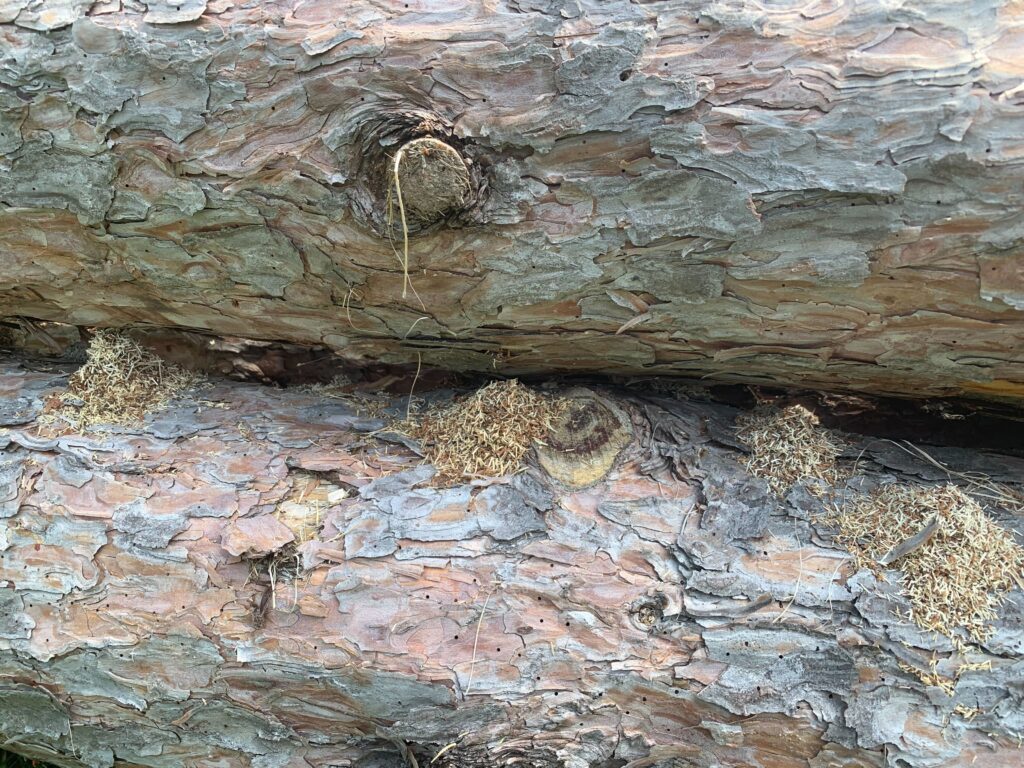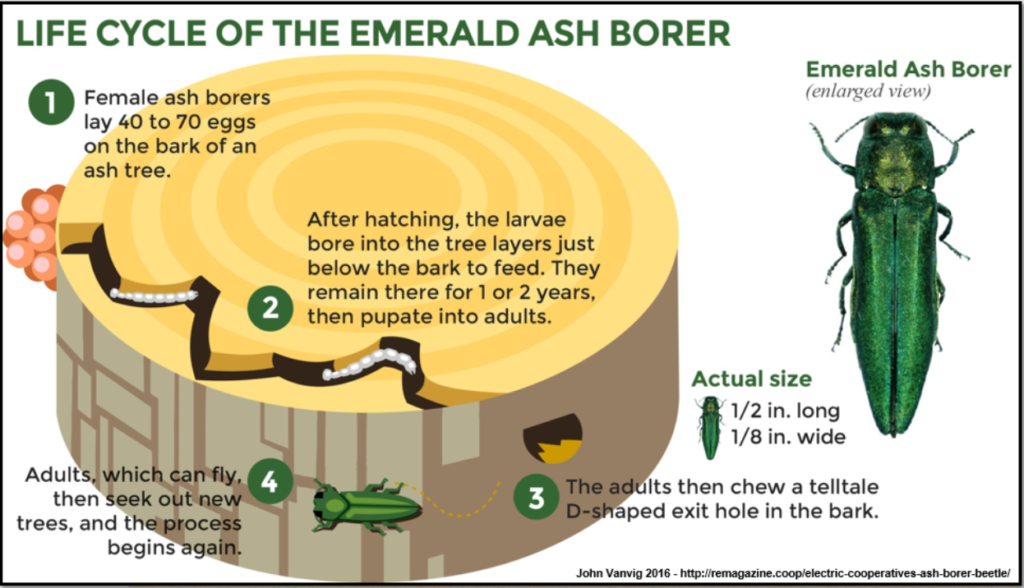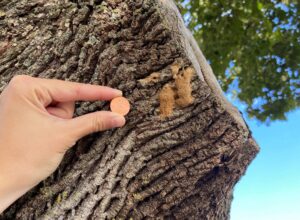It’s that time of year when we look forward to a glowing, crackling fire. Whether you build yours indoors or out, it’s important to source your firewood locally to keep your trees safe from invasive insects that may be hitching a ride!
The incident that prompted my research into this topic was the removal of some Red Pine trees at Monk Botanical Gardens this summer. While removing some of this tree material, our Facilities and Grounds Director, Pat Murphy, sent a picture and message to our Slack channel: “Snap. Crackle. Pop! You can hear them boring in the wood cut from the shade garden.”

The picture showed part of a downed Red Pine tree, with sawdust spilling from holes in the trunk. There was some species of pine-boring beetle feeding on the tree, though we didn’t find out what species exactly. We were worried about moving the wood even to another area of the garden, in case the insects decided to crawl out and find new pine trees to munch on!
And herein lies the same issue with transporting firewood.
Insects have been hitching a ride on human-transported materials for centuries, and this is often how invasive species are introduced to new areas. This problem is only compounded by the fact that it is often eggs or larvae hitching a ride, rather than the easier-to-see adult insects.
Two insects are of particular importance in Wisconsin; the Spongy Moth, and the Emerald Ash Borer. In fact, the Emerald Ash Borer (EAB) first arrived in the United States inside the wood of shipping crates. EAB has been devastating to Ash trees all across the United States because the larvae of the insect feed on tissue just under the bark of the tree- which is the tissue trees rely on to transport sugars to feed themselves! In Wisconsin, all but 4 counties have detected EABs but despite this, state forests are mostly free from the damaging insects. In order to continue keeping our forests safe, the Department of Natural Resources recommends not transporting any ‘raw’ wood of Ash trees (wood that has not been treated against EAB).

The other insect of concern in Wisconsin is the Spongy Moth. Spongy moth was introduced in the late 1800’s and has since defoliated millions of acres of trees across the Eastern and Midwest United States. Unlike the Emerald Ash Borer, Spongy moth feeds on over 300 species of trees, making their damage more widespread. Caterpillars of the Spongy Moth will eat the leaves of trees, causing defoliation- similar to what the Japanese Beetles did at Monk Gardens this summer. Most counties in Wisconsin are under quarantine for Spongy Moth, and it is illegal to transport any items that could be harboring Spongy Moth adults, larvae, or eggs from quarantined counties. This quarantine does not just cover firewood, but plant materials of any kind and even outdoor furniture. Anything that has spent time outside could be harboring a mass of Spongy Moth eggs, which can look like nothing more than a bit of fuzz- that actually contains hundreds of eggs. For a full list of quarantined items and information on what to do, follow the link at the end for the Wisconsin Spongy Moth Quarantine Page.

For the safety of the trees in your yard or someone else’s, please source your firewood locally or only transport firewood that is certified by DATCP (the Wisconsin Department of Agriculture, Trade, and Consumer Protection). In general, no matter where you are in the United States, there are probably guidelines for the safe transport of plant materials, so even if vacationing outside Wisconsin, be safe, do your research, and ‘Buy it Where You Burn It’.
Written by Cora Borgens, Horticulture Manager
Want more Gardens news directly to your inbox?
Sign up for our mailing list!
Helpful Links:
Emerald Ash Borer: https://dnr.wisconsin.gov/topic/foresthealth/emeraldashborer
Spongy Moth: https://dnr.wisconsin.gov/topic/foresthealth/spongymoth
Wisconsin Spongy Moth Quarantine Page: https://datcp.wi.gov/Pages/Programs_Services/SMQuarantineRegs.aspx
Information on Moving Firewood elsewhere in the United States: https://www.dontmovefirewood.org/ , https://www.dontmovefirewood.org/map/
Images:
Pine borer damage- Pat Murphy
Emerald Ash Borer Lifecycle- https://www.urbanforestdweller.com/wp-content/uploads/2020/05/EAB_LifeCycle-1024×588.png
Spongy Moth Egg mass- https://widnr.widen.net/content/ngxwzhmytd/jpeg/Gypsy%20Moth%20Egg%20Mass%20copy.jpg?position=c&color=cccccc&quality=80&u=jxqttz

